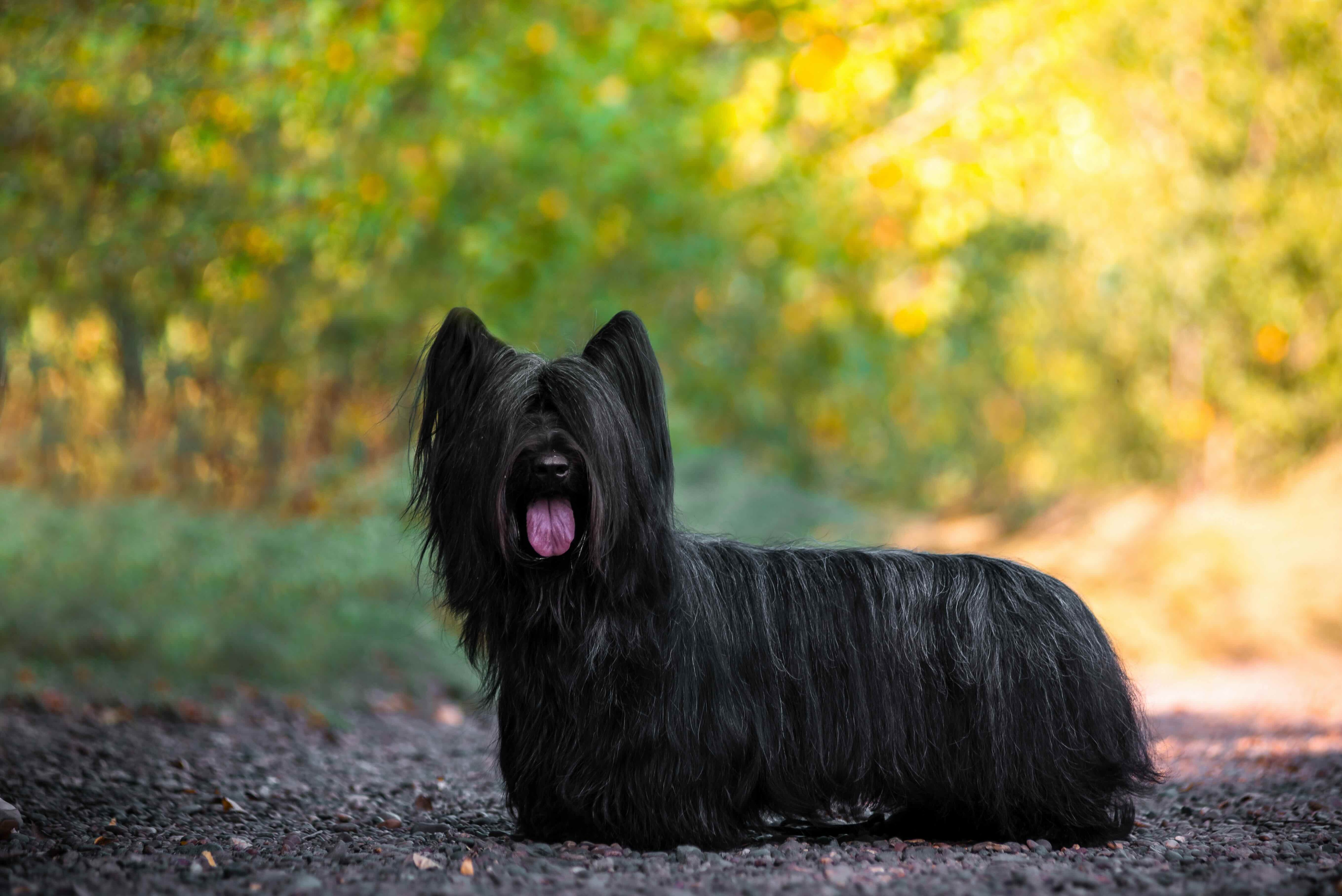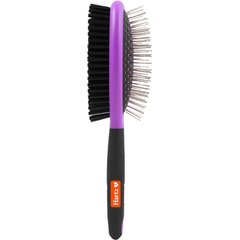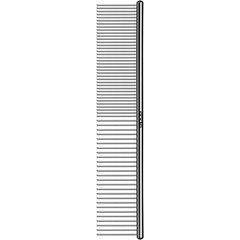Skye Terrier
Adobe Stock/Dogs
The Skye Terrier originated in the northern isles of Scotland. In fact, the region’s largest island, Skye, inspired the breed’s name.
The first thing you might notice about this terrier breed is the long, flowing coat that covers the body, face, and ears. The fur comes in an assortment of colors, including black, blue, platinum, fawn, and cream. Skye Terriers stand about 10 inches at the shoulder and weigh 35–45 pounds.
Although Skye Terrier dogs are compact in size, Sue Chandler, a breeder and member of the Skye Terrier Club of America (STCA), says these dogs are more capable and versatile than they appear.
“They are well-suited to both country and city life,” she says. “As medium dogs on small legs, they can live in a home of any size, provided that they are exercised outside at regular intervals during the day.”
Caring for a Skye Terrier
The Skye Terrier dog breed is a companion that’s confident and active enough to take on a variety of activities alongside you. These dogs are high-energy and need about an hour of exercise each day.
“They love walks, running on a deck, or exploring a fenced-in yard,” says Chandler. After getting in some exercise, Skye Terrier dogs are content to relax at home with family members.
As you might expect from the breed’s long hair, regular grooming is part of life with a Skye Terrier. However, the grooming routine isn’t as rigorous as you might expect, and you can make a trip to the groomer to have the dogs’ coat clipped short for an especially low-maintenance option.
Skye Terrier Health Issues

Skye Terriers are robust and sturdy dogs that aren’t overly prone to frequent health problems. However, it’s important to be alert to changes in your dog’s routine or behavior that may indicate an emerging health concern.
You can gain further understanding of your Skye Terrier’s health by screening them for over 230 genetic health conditions with a dog DNA test.
It’s also worth noting that the Skye Terrier is about twice as long as they are tall. Despite this, back issues are not common, according to the STCA. However, Chandler says it’s important to not overexercise these dogs during their first year of life until the growth plates in their bones have closed.
When well cared for, Skye Terrier dogs usually live 12–14 years.
Cancer
Cancer is one of the more common health concerns for Skye Terriers. In particular, these dogs are among one of the most frequent breeds to be diagnosed with hemangiosarcoma, a subtle and aggressive cancer that originates in the heart or spleen.
Symptoms can vary and include:
Schedule a vet appointment if you notice changes in your pet’s health. Treatment may include surgery, medications, and/or chemotherapy.
Hip or Elbow Dysplasia
Although it’s frequently associated with large breed dogs, hip dysplasia and elbow dysplasia are sometimes noted in Skye Terrier dogs. These are both orthopedic conditions that affect a dog’s mobility and can lead to arthritis.
The most common symptoms include limping, an abnormal hopping motion, or a reluctance to jump up on furniture. Anti-inflammatory medicines can be used to reduce pain and surgical intervention may be an option for more advanced cases.
What To Feed a Skye Terrier
High-quality nutrition and a regular meal routine will support the overall health of your Skye Terrier. Consult your veterinarian to develop a feeding plan that supports your dog’s specific nutritional needs, life stage, and health concerns.
Your chosen dog food should meet the nutritional standards set by the Association of American Feed Control Officials (AAFCO). Skye Terrier puppies need to eat a high-quality puppy food before switching to an adult formula when they’re around 1 year old.
How To Feed a Skye Terrier
A Skye Terrier will usually benefit the most when fed two meals daily—one in the morning and one in the evening. A Skye Terrier puppy might need more frequent feedings (up to four per day) to prevent hypoglycemia (low blood sugar).
Talk to your vet to determine the best feeding schedule for your dog.
How Much Should You Feed a Skye Terrier?
The right amount to feed your Skye Terrier largely depends on your dog’s weight and body condition score. Check the nutrition label on your dog food to gauge the serving size for your dog.
If you notice that your dog is under or over a healthy body weight, ask your veterinarian for help determining how much to feed your Skye Terrier with your dog’s age, body condition score, lifestyle, and health needs in mind.
It’s also important that you factor in the calories that you feed your Skye Terrier in the form of treats or other additions to their diet, such as dental chews. These calories add up and shouldn’t be more than 10% of your dog’s total daily caloric intake.
Nutritional Tips for Skye Terriers
When fed a balanced, AAFCO-compliant dog food, a healthy Skye Terrier isn’t likely to need supplements.
However, discuss specific health concerns with your vet, who may be able to suggest supplement strategies or a prescription diet to address your dog’s needs. Always talk with your veterinarian before starting your dog on a supplement.
Behavior and Training Tips for Skye Terriers
Skye Terrier Personality and Temperament

With proper care and training, a Skye Terrier has a balanced personality. These dogs aren’t generally hyperactive, but they aren’t couch potatoes, either. They have the drive and stamina to engage in a variety of activities and respond well to gentle, consistent training.
The breed can be somewhat reserved with strangers but forms a deep and close bond with their family. “Although Skyes may be selective as to whom they give their deepest affection, their intense loyalty and devotion is truly unsurpassed by any other breed,” says Chandler.
When socialized from an early age with children, Skye Terrier dogs make a playful and tolerant companion. These dogs do have a strong prey drive from their origins as small-game hunters, but Skye Terriers can be trained to cohabit with other smaller pets, like cats.
That said, it’s always wise to supervise your dog around children or small animals, especially if the situation is unfamiliar for your dog.
Skye Terrier Behavior
Skye Terriers tend to be confident and assured, but those qualities require the support of consistent training from an early age.
Shine Sturtz, a Skye Terrier pet parent, stresses the importance of positive socialization for a Skye Terrier puppy. Once a Skye Terrier feels comfortable, the breed’s personality blossoms and these dogs are very playful, spunky, and affectionate.
Skye Terrier Training
The most important thing to know about training a Skye Terrier is how smart and sensitive the breed is. A heavy-handed or loud approach can cause these dogs to shut down, says Sturtz.
Always use positive reinforcement when training a Skye Terrier. Keep training sessions consistent, and teach your dog that following your request leads to a reward, like a treat or a favorite toy.
“As terriers, they are independent; they aren't exactly people-pleasers, like a Golden Retriever,” Chandler says. Still, the breed has a willingness to work alongside you—and with consistency and positive reinforcement, the Skye Terrier is very trainable.
Fun Activities for Skye Terriers
-
Nose work
-
Going on walks
-
Backyard playtime
Skye Terrier Grooming Guide

The Skye Terrier sports a long double coat. The straight outer layer protects a shorter, softer, and somewhat wooly undercoat. The coat hangs straight down and is typically at least 5.5 inches long, per the breed standard.
The long hair of the Skye Terrier is part of the breed’s unique appearance, but it requires regular maintenance that a potential pet parent should be aware of. If you keep your dog in a long, full coat, expect outside debris to hitch a ride in your dog’s fur.
Skye Terriers also shed moderately. Regularly brushing your dog can help remove sticks and snarls while minimizing the amount of shed hair that lands on your furniture, floors, and clothes.
Skin Care
The Skye Terrier typically doesn’t have special skin care requirements. The double coat protects the skin and only requires an occasional bath.
How often you bathe your dog depends on their lifestyle, the time of year, and if your Skye Terrier has a health or skin condition. Ask your vet about the best bathing schedule for your dog.
When bathing a Skye Terrier, care should be taken to minimize breakage of the long, fine coat, according to the breed club. Instead of scrubbing the hair, gently smooth shampoo over the coat before rinsing completely. Repeat for conditioner.
You can either gently comb the coat while it’s still damp or wait until the coat is dry to brush it out.
Recommended Products
Coat Care
A Skye Terrier needs frequent brushing to maintain a healthy and clean coat. “Keeping the hair long means brushing to the skin at least once a week, if not more,” says Sturtz.
Frequent brushing is required to remove tangles and prevent matting, and Sturtz says it’s especially important to be vigilant about removing tangles from areas like behind the front legs. To minimize the amount of upkeep, keep the coat clipped short—either by taking the dog to the groomer regularly or learning to trim the coat yourself.
Whichever route you go, Chandler says the Skye Terrier’s coat is easier to maintain in comparison to other terriers that require regular hand-stripping.
For keeping up on your Skye’s coat, Chandler recommends two simple grooming tools: a pin brush and a comb. She adds that a little trimming with scissors around the feet can help facilitate the dog’s movement as well as prevent matting between the toes and debris collecting in the fur.
Recommended Products
Eye Care
Although no special eye care is needed for this breed, a Skye Terrier’s hair does grow down in front of the eyes, creating heavy bangs. “Even though their hair covers their eyes, Skyes can see,” Chandler says.
Even still, some Skye pet parents trim the hair from the corners of the eyes to prevent it from irritating the eye.
Ear Care
Most Skye Terriers have prick ears that are set high on the head, but a small minority have folded ears that drop down next to the head. In either case, the ears are covered with hair—and the most important aspect of ear care is to ensure the fringe is gently combed out.
During your regular grooming session, inspect the inside of the ear for signs of an ear infection, like redness, odor, or discharge. Talk to your vet if you notice any symptoms.
Considerations for Pet Parents
Before you bring home a Skye Terrier puppy, understand the care requirements for the breed.
Keep in mind that though these dogs are compact, they require regular exercise and consistent training. However, they are adaptable enough to live in small spaces, as long as they’re taken for frequent walks throughout the day.
Because Skye Terriers enjoy the company of their human family, they do best when they aren’t left alone for the majority of the day. And don’t overlook the importance of maintaining the Skye Terrier’s beautiful coat, which is sure to turn heads on your daily walks.
Skye Terrier FAQs
Do Skye Terriers bark a lot?
All dogs bark, but Skye Terriers aren’t known to be excessive barkers. They may bark to alert their pet parents or during play.
How rare is a Skye Terrier?
Skye Terriers are one of the rarest dog breeds in the U.S., with the AKC ranking them the 185th (out of 200) most popular breed.
Are Skye Terriers cuddly?
The personality of each dog varies, and early socialization has a bearing on how much affection a dog shows. However, Skye Terriers are known to be very affectionate with their family members, and they enjoy sharing your personal space and being petted.




